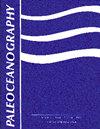{"title":"Relationships Between Temperature, pH, and Crusting on Mg/Ca Ratios in Laboratory‐Grown Neogloboquadrina Foraminifera","authors":"C. V. Davis, J. Fehrenbacher, T. Hill, A. Russell, H. Spero","doi":"10.1002/2017PA003111","DOIUrl":null,"url":null,"abstract":"Author(s): Davis, CV; Fehrenbacher, JS; Hill, TM; Russell, AD; Spero, HJ | Abstract: ©2017. American Geophysical Union. All Rights Reserved. Mg/Ca ratio paleothermometry in foraminifera is an important tool for the reconstruction and interpretation of past environments. However, existing Mg/Ca:temperature relationships for planktic species inhabiting middle- and high-latitude environments are limited by a lack of information about the development and impact of low-Mg/Ca ratio “crusts” and the influence of the carbonate system on Mg/Ca ratios in these groups. To address this, we cultured individual specimens of Neogloboquadrina incompta and Neogloboquadrina pachyderma in seawater across a range of temperature (6°–12°C) and pH (7.4–8.2). We found by laser ablation inductively couple mass spectrometry analyses of shells that culture-grown crust calcite in N. incompta had a lower Mg/Ca ratio than ontogenetic calcite formed at the same temperature, suggesting that temperature is not responsible for the low-Mg/Ca ratio of neogloboquadrinid crusts. The Mg/Ca:temperature relationship for ontogenetic calcite in N. incompta was consistent with the previously published culture-based relationship, and no significant relationship was found between Mg/Ca ratios and pH in this species. However, the Mg/Ca ratio in laboratory-cultured N. pachyderma was much higher than that reported in previous core top and sediment trap samples, due to lack of crust formation in culture. Application of our ontogenetic calcite-specific Mg/Ca:temperature relationships to fossil N. pachyderma and N. incompta from five intervals in cores from the Santa Barbara Basin and the Bering Sea shows that excluding crust calcite in fossil specimens may improve Mg/Ca-based temperature estimates.","PeriodicalId":19882,"journal":{"name":"Paleoceanography","volume":"32 1","pages":"1137-1152"},"PeriodicalIF":0.0000,"publicationDate":"2017-11-01","publicationTypes":"Journal Article","fieldsOfStudy":null,"isOpenAccess":false,"openAccessPdf":"https://sci-hub-pdf.com/10.1002/2017PA003111","citationCount":"21","resultStr":null,"platform":"Semanticscholar","paperid":null,"PeriodicalName":"Paleoceanography","FirstCategoryId":"1085","ListUrlMain":"https://doi.org/10.1002/2017PA003111","RegionNum":0,"RegionCategory":null,"ArticlePicture":[],"TitleCN":null,"AbstractTextCN":null,"PMCID":null,"EPubDate":"","PubModel":"","JCR":"","JCRName":"","Score":null,"Total":0}
引用次数: 21
温度、pH值和结壳对实验室培养的新舌形有孔虫Mg/Ca比值的影响
作者:Davis,简历;费伦巴彻,JS;Hill,TM;拉塞尔,AD;斯佩罗,HJ |摘要:©2017。美国地球物理联合会。保留所有权利。有孔虫Mg/Ca比值古温度测量是重建和解释过去环境的重要工具。然而,居住在中高纬度环境中的浮游物种现有的Mg/Ca:温度关系受到缺乏关于低Mg/Ca比“结壳”的发展和影响以及碳酸盐体系对这些群体中Mg/Ca比率的影响的信息的限制。为了解决这一问题,我们在温度(6°-12°C)和pH(7.4–8.2)范围内的海水中培养了新球藻和厚壳新球藻的个体标本。我们通过对贝壳的激光烧蚀电感耦合质谱分析发现,在北半球培养生长的地壳方解石的Mg/Ca比低于在相同温度下形成的个体生成方解石,表明温度不是新球壳Mg/Ca比值低的原因。N.incpta个体发育方解石的Mg/Ca:温度关系与之前发表的基于培养的关系一致,并且在该物种中没有发现Mg/Ca比率与pH之间的显著关系。然而,由于培养中缺乏结皮,实验室培养的厚皮猪笼草的Mg/Ca比远高于以前的岩心顶部和沉积物捕获器样品。我们在圣巴巴拉盆地和白令海岩芯中五个层段的厚皮猪笼草和无盖猪笼草化石中应用的个体成因方解石特异性Mg/Ca:温度关系表明,在化石标本中排除地壳方解石可能会改善基于Mg/Ca的温度估计。
本文章由计算机程序翻译,如有差异,请以英文原文为准。


